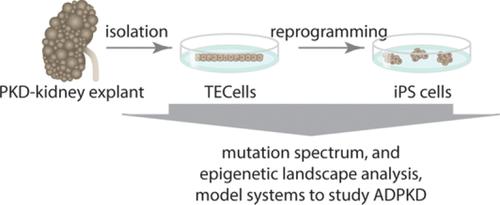当前位置:
X-MOL 学术
›
Stem Cells Transl. Med.
›
论文详情
Our official English website, www.x-mol.net, welcomes your
feedback! (Note: you will need to create a separate account there.)
Cystic renal-epithelial derived induced pluripotent stem cells from polycystic kidney disease patients.
STEM CELLS Translational Medicine ( IF 5.4 ) Pub Date : 2020-03-12 , DOI: 10.1002/sctm.18-0283 Annegien T Kenter 1, 2, 3 , Eveline Rentmeester 1 , Job van Riet 4 , Ruben Boers 1 , Joachim Boers 1, 5 , Mehrnaz Ghazvini 1 , Vanessa J Xavier 1 , Geert J L H van Leenders 6 , Paul C M S Verhagen 7 , Marjan E van Til 8 , Bert Eussen 8 , Monique Losekoot 9 , Annelies de Klein 8 , Dorien J M Peters 10 , Wilfred F J van IJcken 11 , Harmen J G van de Werken 4 , Robert Zietse 3 , Ewout J Hoorn 3 , Gert Jansen 2 , Joost H Gribnau 1
STEM CELLS Translational Medicine ( IF 5.4 ) Pub Date : 2020-03-12 , DOI: 10.1002/sctm.18-0283 Annegien T Kenter 1, 2, 3 , Eveline Rentmeester 1 , Job van Riet 4 , Ruben Boers 1 , Joachim Boers 1, 5 , Mehrnaz Ghazvini 1 , Vanessa J Xavier 1 , Geert J L H van Leenders 6 , Paul C M S Verhagen 7 , Marjan E van Til 8 , Bert Eussen 8 , Monique Losekoot 9 , Annelies de Klein 8 , Dorien J M Peters 10 , Wilfred F J van IJcken 11 , Harmen J G van de Werken 4 , Robert Zietse 3 , Ewout J Hoorn 3 , Gert Jansen 2 , Joost H Gribnau 1
Affiliation

|
Autosomal‐dominant polycystic kidney disease (ADPKD) is the most common inherited kidney disease, leading to kidney failure in most patients. In approximately 85% of cases, the disease is caused by mutations in PKD1. How dysregulation of PKD1 leads to cyst formation on a molecular level is unknown. Induced pluripotent stem cells (iPSCs) are a powerful tool for in vitro modeling of genetic disorders. Here, we established ADPKD patient‐specific iPSCs to study the function of PKD1 in kidney development and cyst formation in vitro. Somatic mutations are proposed to be the initiating event of cyst formation, and therefore, iPSCs were derived from cystic renal epithelial cells rather than fibroblasts. Mutation analysis of the ADPKD iPSCs revealed germline mutations in PKD1 but no additional somatic mutations in PKD1/PKD2. Although several somatic mutations in other genes implicated in ADPKD were identified in cystic renal epithelial cells, only few of these mutations were present in iPSCs, indicating a heterogeneous mutational landscape, and possibly in vitro cell selection before and during the reprogramming process. Whole‐genome DNA methylation analysis indicated that iPSCs derived from renal epithelial cells maintain a kidney‐specific DNA methylation memory. In addition, comparison of PKD1+/− and control iPSCs revealed differences in DNA methylation associated with the disease history. In conclusion, we generated and characterized iPSCs derived from cystic and healthy control renal epithelial cells, which can be used for in vitro modeling of kidney development in general and cystogenesis in particular.
中文翻译:

囊性肾上皮来源的多囊肾病患者诱导的多能干细胞。
常染色体显性多囊肾(ADPKD)是最常见的遗传性肾脏疾病,导致大多数患者出现肾衰竭。在大约85%的情况下,该疾病是由PKD1突变引起的。PKD1的失调如何在分子水平上导致囊肿形成尚不清楚。诱导多能干细胞(iPSC)是遗传疾病的体外建模的强大工具。在这里,我们建立了ADPKD患者特异性iPSC,以研究PKD1的功能在体外肾脏发育和囊肿形成。体细胞突变被认为是囊肿形成的起始事件,因此,iPSC来源于囊性肾上皮细胞而不是成纤维细胞。ADPKD iPSC的突变分析显示PKD1中的种系突变,但PKD1 / PKD2中没有其他体细胞突变。尽管在囊性肾上皮细胞中发现了与ADPKD相关的其他基因中的一些体细胞突变,但在iPSC中仅存在这些突变中的少数,表明异质性突变格局,并可能在重编程过程之前和期间进行了体外细胞选择。全基因组DNA甲基化分析表明,源自肾上皮细胞的iPSC保留了肾脏特异性DNA甲基化记忆。此外,PKD1 +/-和对照iPSC的比较显示与疾病史相关的DNA甲基化差异。总之,我们生成并表征了来自囊性和健康对照肾上皮细胞的iPSC,这些iPSC可以用于一般情况下肾脏发育的体外建模,尤其是用于囊肿发生的体外建模。
更新日期:2020-03-12
中文翻译:

囊性肾上皮来源的多囊肾病患者诱导的多能干细胞。
常染色体显性多囊肾(ADPKD)是最常见的遗传性肾脏疾病,导致大多数患者出现肾衰竭。在大约85%的情况下,该疾病是由PKD1突变引起的。PKD1的失调如何在分子水平上导致囊肿形成尚不清楚。诱导多能干细胞(iPSC)是遗传疾病的体外建模的强大工具。在这里,我们建立了ADPKD患者特异性iPSC,以研究PKD1的功能在体外肾脏发育和囊肿形成。体细胞突变被认为是囊肿形成的起始事件,因此,iPSC来源于囊性肾上皮细胞而不是成纤维细胞。ADPKD iPSC的突变分析显示PKD1中的种系突变,但PKD1 / PKD2中没有其他体细胞突变。尽管在囊性肾上皮细胞中发现了与ADPKD相关的其他基因中的一些体细胞突变,但在iPSC中仅存在这些突变中的少数,表明异质性突变格局,并可能在重编程过程之前和期间进行了体外细胞选择。全基因组DNA甲基化分析表明,源自肾上皮细胞的iPSC保留了肾脏特异性DNA甲基化记忆。此外,PKD1 +/-和对照iPSC的比较显示与疾病史相关的DNA甲基化差异。总之,我们生成并表征了来自囊性和健康对照肾上皮细胞的iPSC,这些iPSC可以用于一般情况下肾脏发育的体外建模,尤其是用于囊肿发生的体外建模。











































 京公网安备 11010802027423号
京公网安备 11010802027423号